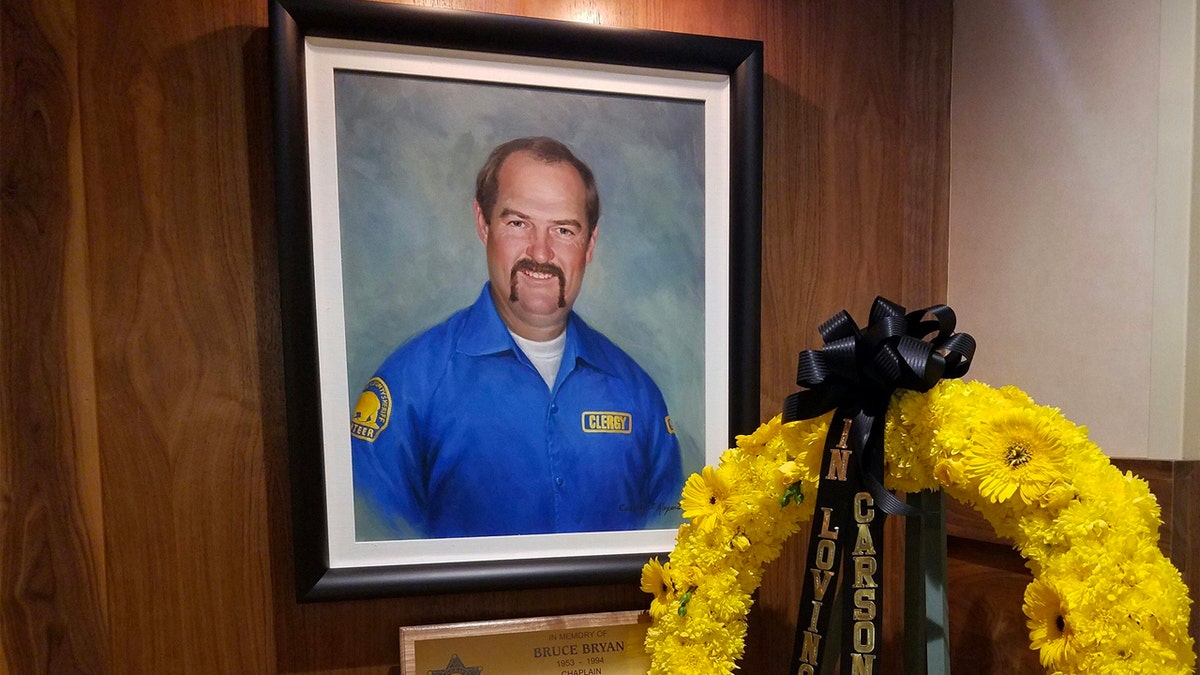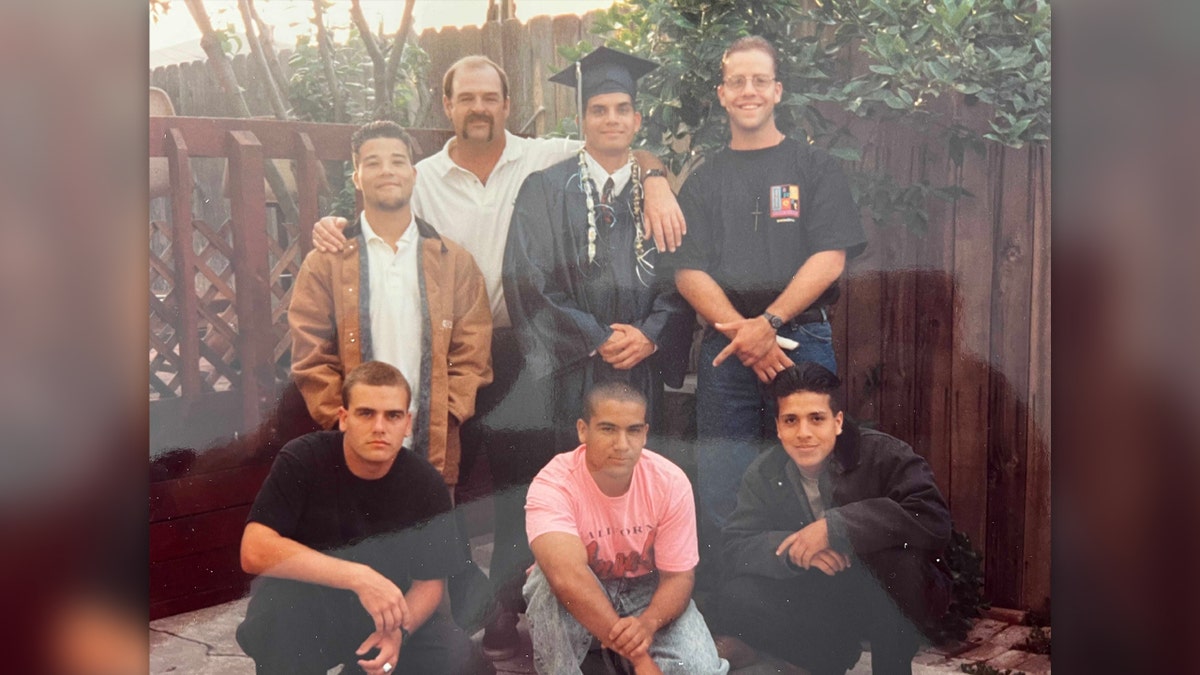Los Angeles DA George Gascon in spotlight for ignoring prison recommendation in attempted-murder case
Fox News' Bill Melugin reports the latest on the decision from Los Angeles.
Derek Eugene Pettis, a 24-year-old gang member, found himself handcuffed in the back seat of a squad car after a drunken bar fight in 1994, but the Los Angeles deputy who placed him there wasn't going to bring him to jail.
Deputy Terrence Wenger, 31, and volunteer chaplain Bruce Bryan, a 39-year-old in the car on a ride-along, took Pettis home to sober up.
Rather than thank them, Pettis hit Wenger over the head as soon as he was free from his handcuffs.
"They took him home instead of taking him to jail, and that’s the hardest part to understand," Bryan's brother, Floyd Bryan, told Fox News Digital. "They dropped him off a block from where he lived, and when he got out he hit the deputy, grabbed his gun and shot him in the head."

A portrait of Bruce Bryan, the 39-year-old volunteer chaplain who Derek Pettis shot and killed in 1994, hangs above a memorial plaque at the Carson Sheriff's Station, where he spent a lot of time. (Carson Sheriff's Station / Facebook)
Pettis received a sentence of life in prison with a chance for parole after 40 years, Bryan said. Now, after an update to state laws on "youth offender" status, Pettis has been granted parole more than a decade earlier than the family expected.
Back on June 18, 1994, Pettis grabbed the gun from an unconscious Wenger and fired multiple shots at him, but only one struck – costing the deputy an eye. Then the killer turned on Bryan, who tried to flee.
"He chased my brother, shot him in the back," Floyd Bryan said. "He had a vest on, so as he was on his knees trying to get up, he shot him again straight down between his shoulder there where there wasn’t a vest and killed him."
Pettis on some level knew Bryan, according to his brother. He was in the same gang as another man who lived next door to where the ordained minister ran a youth mission for troubled young men and boys.

In addition to his work as a volunteer chaplain, Bruce Bryan ran a mission for troubled youths at his own home and got them work in a gardening business, according to his brother, Floyd. He said some of the men in this photo grew up to work in the computer industry. (Floyd Bryan)
Pettis, now 54, was captured, convicted and sentenced to life in prison. He first became eligible for parole in 2018 and was finally granted it at a Sept. 6 parole board hearing, records show.
But under the original sentence, Pettis shouldn't have been eligible for another 11 years, the victim's brother said. State laws have been revised, raising the age of "youth offender" status several times over the past few decades, from 18 to 23 and now 26. The killer was 24 at the time, and the status has been applied retroactively, he said.
"I just have a major problem with the law changes affecting people of this nature," Bryan told Fox News Digital. "This was a violent crime. This is the top of violent crimes other than maybe rape. Anybody who shoots anybody in law enforcement is really making a statement that they don’t care who they kill because if you’re going to kill law enforcement, you’re going to kill anybody."
CALIFORNIA JUDGE SEEKS TO BAR LEFT-WING COLLEAGUE FROM RESENTENCING COP KILLER

A memorial plaque dedicated to Bruce Bryan hangs at the Carson Sheriff's Station in California. (Carson Sheriff's Station / Facebook)
Furthermore, he said, deputies and prosecutors were banned from speaking at the parole board hearing.
Under state law, the board's decision will go to Gov. Gavin Newsom for review, and supporters of law enforcement and the Bryan family are hoping he overrules it.
"In all cases, the Governor carefully reviews parole cases to determine whether a parole grant is consistent with public safety," Newsom's office said in a statement. "This process can take up to 150 days."
"We’re going to call him a youthful offender? That is not what anybody intended," said John Lewin, a longtime deputy district attorney in Los Angeles County and a vocal critic of soft-on-crime progressive policies. "This is a guy who intentionally and violently executed a chaplain, who was begging for his life and was not even a police officer."

California Gov. Gavin Newsom, above, will have final say over whether Derek Pettis can be freed on parole for the murder of Los Angeles volunteer chaplain Bruce Bryan. (AP Photo / Rich Pedroncelli / File)
Under one of those policies, put in place by Lewin's boss, District Attorney George Gascon, prosecutors are not allowed to be present at parole hearings or argue against the release of a convict.
That puts a crippling burden on victims or their families who argue against release. Defense attorneys and members of the parole commission are all given access to the defendant's case file, including a psychological evaluation, Lewin said. Prosecutors would have that, too, if they were present, but family members don't.
"Family members, they don’t have half the information, so it means that they can't make coherent arguments," he said. "In addition, you don’t have anybody who is up there representing the victims and representing society at large."
VICTIM OF BARNES & NOBLE 'SNIFFER' BLASTS REPEATED CATCH-AND-RELEASE: ‘HE IS UNFIT FOR SOCIETY’
According to a memorial plaque at the Los Angeles Sheriff's Carson Station, Bryan earned the nickname "Chaplain of the Hood" because he spent so much time counseling youthful offenders on the hood of a squad car.
"Chaplain Bruce was a full time service volunteer doing the work of God," the Carson Station said in a 2016 tribute to the slain minister. "He visited youthful offenders at juvenile detention facilities, opened his home to troubled men and participated in ride-alongs several times a week."
Bryan ran a nonprofit halfway house for troubled juveniles out of his home, his brother said. He offered them jobs at a gardening business and helped them get back into school or find new careers.

This view shows a Los Angeles County Sheriff's Department vehicle. (Los Angeles County Sheriff's Department)
The Los Angeles Times reported shortly after his murder that he was engaged to be married when he died.
"An individual who’s this cold-hearted, who is this brutal, this maniacal, we’re going to let him free?" Lewin added. "What happens when he gets mad at the next person?"
As for Wenger, he lost an eye but survived after major surgery and returned to work at the sheriff's department until he retired years later.
CLICK HERE TO GET THE FOX NEWS APP
In a statement to the parole board published by the Los Angeles news site The Current Report, the survivor called the double shooting "extremely vicious, sadistic and cruel" and argued against Pettis' release. However, Bryan said he does not recall it being read aloud at the hearing.
"How can we know this evil will not again erupt following a sudden outburst of anger on his part?" Wenger wrote. "It happened once, and there is zero guarantee it won’t happen again."
Bryan is worried about the same thing, especially if Pettis falls back into his old vices.
"I'm beside myself even talking about it," he said. "I really have a problem if he gets out and hurts somebody because it doesn’t take much to have a drink or do drugs."


